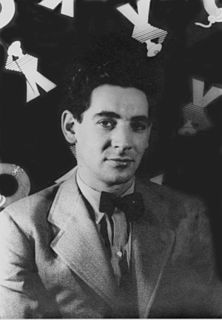Related Research Articles
In musical terminology, tempo is the speed or pace of a given piece. In classical music, tempo is typically indicated with an instruction at the start of a piece and is usually measured in beats per minute. In modern classical compositions, a "metronome mark" in beats per minute may supplement or replace the normal tempo marking, while in modern genres like electronic dance music, tempo will typically simply be stated in bpm.
The Variations on a Nursery Tune, Op. 25, is a piece for piano and orchestra by Ernő Dohnányi. It is subtitled For the enjoyment of humorous people and for the annoyance of others.
Ozan Marsh was a pianist active in concert performances throughout the world as well as across the United States.
Sergei Prokofiev's Violin Sonata No. 2 in D Major, Op. 94a, was based on the composer's own Flute Sonata in D, Op. 94, written in 1942 but arranged for violin in 1943 when Prokofiev was living in Perm in the Ural Mountains, a remote shelter for Soviet artists during the Second World War. Prokofiev transformed the work into a violin sonata at the prompting of his close friend, the violinist David Oistrakh. It was premiered on 17 June 1944 by David Oistrakh and Lev Oborin.
Sergei Prokofiev set about composing his Piano Concerto No. 1 in D-flat major, Op. 10, in 1911, and finished it the next year. The shortest of all his concertos, it is in one movement, about fifteen minutes in duration, and dedicated to the “dreaded Tcherepnin.”

The Sonata on the 94th Psalm in C minor is a sonata for solo organ by Julius Reubke, based on the text of Psalm 94. It is considered one of the pinnacles of the Romantic repertoire.
The Piano Concerto No. 3 in D major, Op. 50 by Russian composer Dmitri Kabalevsky is one of three concertos written for and dedicated to young performers within the Soviet Union in 1952, and is sometimes performed as a student's first piano concerto. This sunny and tuneful piece manages to combine effective apparent pianistic pyrotechnics whilst keeping it within the range of ability of a keen student.
Variations on a Theme of Corelli, Op. 42, is set of variations for solo piano, written in 1931 by the Russian composer Sergei Rachmaninoff. He composed the variations at his holiday home in Switzerland.
The Piano Sonata No. 29 ''Sonata Etere'' Op. 129 by Geirr Tveitt is Tveitt's only surviving piano sonata. The piece, though met with disdain by critics upon its publication in the early 1950s, has attained a prominent place among Norwegian piano sonatas.
The Symphony No. 1 Elevamini is an orchestral work by Australian-born composer Malcolm Williamson.
The Piano Sonata No. 1 in C major, Op. 1, of Johannes Brahms was written in Hamburg in 1853, and published later that year. Despite being his first published work, he had actually composed his Piano Sonata No. 2 first, but chose this work to be his first published opus because he felt that it was of higher quality. The piece was sent along with his second sonata to Breitkopf & Härtel with a letter of recommendation from Robert Schumann. Schumann had already praised Brahms enthusiastically, and the sonata shows signs of an effort to impress in its technical demands and dramatic character. It was dedicated to Joseph Joachim.
Dmitry Kabalevsky's Preludes, Op. 38 are a set of 24 piano pieces in the Chopinian model, each based on a folksong and each in a different key. It was composed in 1943–44, and dedicated to Nikolai Myaskovsky, his teacher. It is one of a number of examples of music written in all 24 major and minor keys.

Leonard Bernstein's Piano Trio for piano, violin, and cello was written in 1937 while he was attending Harvard University as a student of Walter Piston. He was influenced by the conductor Dmitri Mitropoulos. Several melodic ideas were recycled for use in later pieces. For example, the opening of the second movement was used later by Bernstein in his first musical, On the Town.
Sergei Prokofiev's Piano Sonata No. 2 in D Minor, Op. 14 (1912), is a sonata composed for solo piano. It was premiered on February 5, 1914 in Moscow with the composer performing. Prokofiev dedicated the work to his friend and fellow student at the St. Petersburg Conservatory, Maximilian Schmidthof, who committed suicide in 1913.
Sergei Prokofiev's Piano Sonata No. 3 in A minor, Op. 28 (1917) is a sonata composed for solo piano, using sketches dating from 1907. Prokofiev gave the première of this in St. Petersburg on April 15, 1918, during a week-long festival of his music sponsored by the Conservatory.
Sergei Prokofiev's Piano Sonata No. 1 in F minor, Op. 1 was written in 1909. It consists of a single movement in sonata form.
Felix Blumenfeld's String Quartet in F major, Op. 26, is the composer's only work for the medium. Published in 1898, the quartet was dedicated to music publisher Mitrofan Belyayev.
The String Sonata No. 1, commonly referred to by its original Italian name Sonata per archi, is a composition for string orchestra by German composer Hans Werner Henze. It was composed between 1957 and 1958.
The Violin Sonata in B minor, P 110, is a sonata for violin and piano by Italian composer Ottorino Respighi, completed in 1917. It is one of Respighi's major large-scale chamber works.
References
- ↑ François-René Tranchefort et al., Guide de la musique de piano et clavecin. Page 436 - Dmitri Kabalevsky, by André Lischke.
| | This article about a sonata is a stub. You can help Wikipedia by expanding it. |